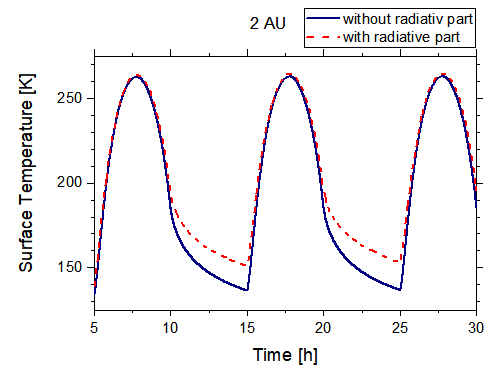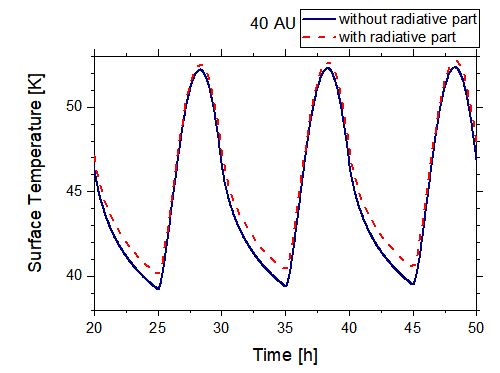Thermophysical modelling of small bodies: influence of the radiative thermal conductivity
- Technische Universität Braunschweig, Institute for Geophysics and extraterrestrial physics, Braunschweig, Germany (d.bischoff@tu-bs.de)
In the Solar System, several different types of small bodies can be found, whose histories can deviate highly from each other, including time and process of formation, followed by collisional or other evolutionary processes. For cometary nuclei, the history and formation remain unsolved and different hypotheses exist, which may explain their past (Weissman et al. 2020). In this study here, the focus lies on the thermophysical properties of small bodies. Different formation scenarios lead to different properties of the resulting bodies. In the scenario of the gravoturbulent collapse of a pebble cloud, macroscopic void spaces remain in the body (e.g. Blum et al. 2014, 2017). In contrast, the hierarchical accretion leads to more compact bodies without large voids (e.g. Davidsson et al. 2016). This effects the thermophysical behaviour, as in the first case, besides the network conductivity of the solid material, also radiation can efficiently transport heat through the voids. The radiative heat conductivity can be described as follows:
λrad = 16/3 σ T3 Λ(Φ)
where σ, T, Λ and Φ are the Stefan-Boltzmann constant, the temperature, the radiative mean free path and the volume filling factor, respectively. The network part of the heat conductivity can be written as
λnet = H λagg/par(T)
with the Hertz factor H and the aggregate or particle thermal conductivity λagg/par (see Gundlach and Blum 2012, and Gundlach et al 2020 for details). The radiative thermal conductivity has a much higher dependency on temperature than the network part.
Here, we address the question, how radiation influences the thermal behaviour of a planetesimal in a measurable way. Therefore, the following steps are foreseen: a thermophysical model is set up, which calculates the heat transport in a small body that is illuminated by the Sun. For simplicity, we assume a circular orbit around the Sun at several heliocentric distances without obliquity and varying rotational periods. The model solves the heat transport equation in a one-dimensional approximation. In this study, we focus on the surface temperature as the output. This is motivated by the measurement capabilities of most spacecraft visiting small bodies. To measure the surface temperature is relatively easy, often done and enough accurate compared to the remote measurements of inner temperatures.


Figure 1 : Results of the thermophysical modelling for 2 AU (left) and 40 AU (right): surface temperature over time for the simulation with (dashed) and without (continuous) radiative part.
With the described model, the influence of the radiative part of the thermal conductivity is studied by varying it in different setups, namely heliocentric distance, and rotation period. Thereby, the Fourier number, which represents the numerical accuracy of the model run, is optimized to be near its favourable value of 0.5. In a first attempt, only the surface temperature of the equator was regarded. An exemplary plot of two model runs is shown in Figure 1 for a rotation period of 10 hours and at heliocentric distances of 2 AU and 40 AU, respectively. For each heliocentric distance, the maximal temperature is similar for the two cases (with and without radiative conductivity) studied, but during the night, cooling behaves differently. In the case of 2 AU, a median thermal conductivity of 0.02 W/(m K) was calculated; for 40 AU, the median thermal conductivity reduces to 0.003 W/(m K). In this colder regime, the differences at night are reduced. In a next step, this analysis will be expanded to the surface temperature of the meridian from pole to equator, assuming a spherical body.
The first results indicate that for some parameter sets, the two scenarios show sufficient differences to be distinguishable by measurement. Comparing the results of our study to measured data from small bodies could allow further insights into the formation or evolutionary paths of small bodies. More detailed results and conclusions will be presented at the EPSC 2020.
Acknowledgement:
This work was funded through the DFG project BL 298/27-1.
References:
Blum J., Gundlach B., Mühle S., Trigo-Rodriguez J. M., 2014, Icarus, 235, 156
Blum J. et al., 2017, MNRAS, 459, S755
Davidsson B. J. R. et al., 2016, A&A, 592, A63
Gundlach B., Blum J., 2012, Icarus, 219, 618
Weissman P., Morbidelli A., Davidsson B., Blum J., 2019, Space Sci. Rev., 216, 6
How to cite: Bischoff, D., Gundlach, B., and Blum, J.: Thermophysical modelling of small bodies: influence of the radiative thermal conductivity, Europlanet Science Congress 2020, online, 21 September–9 Oct 2020, EPSC2020-951, https://doi.org/10.5194/epsc2020-951, 2020

